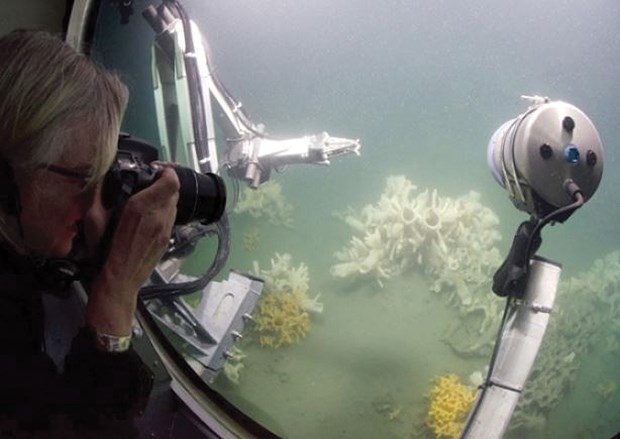Thought to have gone extinct 40 million years ago, the only known gardens of live prehistoric creatures in the world are found flourishing in the coastal waters of B.C.
The ancient glass sponge reefs were first discovered in the Hecate Strait in 1987 by a mapper with the Canadian Geological Survey. More pockets were mapped in 2001 along the Strait of Georgia, making the local waters a rare habitat on the globe.
When scientists confirmed the existence of the reefs deep in B.C. waters, it was like discovering “a herd of dinosaurs,” said Sabine Jessen, oceans director with the Canadian Parks and Wilderness Society, who lives in North Vancouver.
“We don’t really know why they’re only here,” she said. “Except that somehow the conditions must be just perfect for them. They rely on a lot of dissolved silica. Silica basically is glass. It’s dissolved in the ocean water and likely comes from the adjoining mountains. That dissolved silica is critical to their growth.”
The glass reefs found north of the Georgia Strait are roughly the size of an eight-storey building. The sediment at the bottom of these reefs has been dated to about 9,000 years ago, around the end of the last ice age.
Jessen said that these reefs are in danger of being shattered by prawn trawling or crab trapping, and are at the centre of a call for more marine protected areas in the Strait of Georgia.
“They have the consistency of meringue. If something hard touches them, they basically crumble,” said Jessen.
Ground fishing that stirs up sediment can also damage the filter-feeding sponges by smothering them. The reefs are ecologically important because the sponges clean ocean water by feeding on bacteria. They also provide habitat for young rockfish and other animals.
Responding to the increased attention the sponges have received, Environment Minister of B.C., Mary Polak, introduced new legislation in March proposing protections for several areas in the province in need of preservation.
“I think that’s a really good recognition by the province of that really unique sea-floor creature,” Jessen said.
The legislation, if passed, will also protect a recently discovered reef of glass sponges southeast of Gambier Island. The bill proposes a 136-hectare foreshore addition to the protected area at Halkett Bay Marine Park to safely encompass the living reefs. Located in only 30 metres of water, the reef is uniquely accessible for study and observation. Most reefs grow in waters too deep for scientists and divers to safely access.
“The problem is the province doesn’t have the jurisdiction to implement those measures so they’ll need to work with the federal government, in particular the Department of Fisheries and Oceans Canada, to put those kinds of measures in place,” Jessen said. “We hope they’ll take that next step and make sure those kinds of protection measures are put on.”
In 2015 the Department of Fisheries and Oceans set 150-metre buffer zones around nine reefs, which include a cluster near Passage Island off West Vancouver as well as near Defence Islands in Howe Sound, plus others close to communities on the Sunshine Coast and Galiano Island.
The laws prevent harmful fishing activity anywhere near the fragile towers of the sponges.
Jessen credits Jordan Sturdy, MLA for West Vancouver-Sea to Sky, for supporting the issue and representing scientists’ concerns on the political stage.
“The expansion of the Halkett Bay Marine Provincial Park on Gambier Island will help protect these reefs as it provides great opportunities for scientists and scuba enthusiasts. I’m very pleased to see the glass sponge garden added to our province’s protected areas,” Sturdy said in a press release.
Now Jessen and the team of marine specialists at CPAWS is hoping to preserve more of these unique habitats in Howe Sound and throughout the Strait.
“We would like to see a network of marine protected areas put in place,” said Jessen. “It does need to be this collaborative effort. In some cases, if there’s a provincial park put in place, then (the province) needs to work with the federal government and then the federal government, for some of the others, could also establish marine protected areas. There’s a number of tools that could be used.”
The most recent reef thrust into the spotlight was discovered near Prince Rupert in Chatham Sound. While mapping the sea floor for an underwater pipeline project, Spectra Energy came across the 12-kilometre colony of glass sponges lying in the way of their planned route. In an environment assessment application fact sheet published by Spectra in 2014, the company committed to a 200-metre minimum buffer zone to avoid the natural growth and set an example for other invasive projects for the respect of marine life.
– with files from Jacob Roberts/Coast Reporter and Jane Seyd/North Shore News



